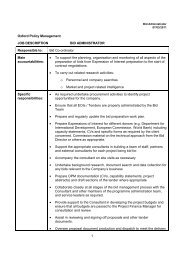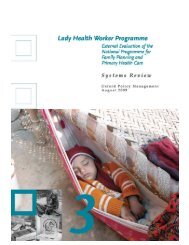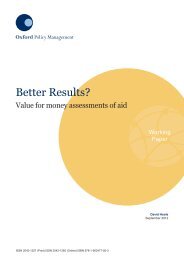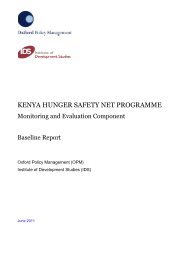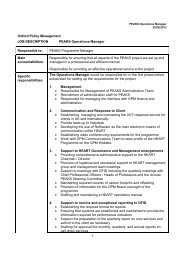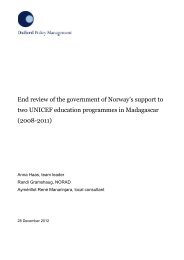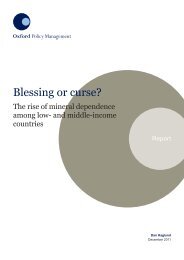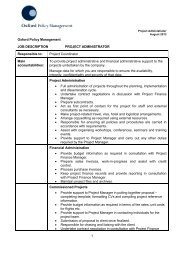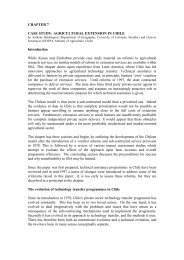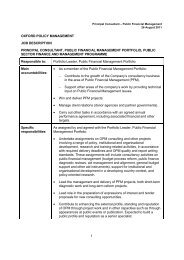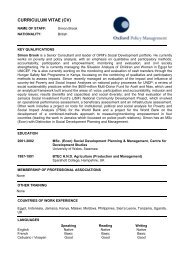LHW Management Review - Oxford Policy Management
LHW Management Review - Oxford Policy Management
LHW Management Review - Oxford Policy Management
Create successful ePaper yourself
Turn your PDF publications into a flip-book with our unique Google optimized e-Paper software.
<strong>LHW</strong>P – <strong>Management</strong> <strong>Review</strong><br />
communication channels backed up by supervision to provide the message that poor<br />
families need greater support.<br />
• Increased collaboration with other organisations that provide basic safety nets would<br />
enable the <strong>LHW</strong> to provide services to the very poor.<br />
6. What have been the benefits and tensions of expansion from 37,000 <strong>LHW</strong> to 90,000<br />
<strong>LHW</strong>s?<br />
• Given concerns about financing and management capacity being insufficient for<br />
Programme expansion, the Strategic Plan proposed a review that would include the<br />
options of reducing the target number of <strong>LHW</strong>s or allocating more resources, or<br />
modifying the level and package of services being provided by <strong>LHW</strong>s. It is not clear<br />
that these options were in fact reviewed. Rather it appears that the target of 100,000<br />
<strong>LHW</strong>s was just retained and more resources were allocated.<br />
• Proposals for expansion of the Programme by Government need to consider the<br />
implications re: funding, sustainability, the opportunities for increasing coverage into<br />
remote areas; the functioning of health facilities and the organizational capability of<br />
the Programme.<br />
• The greatest period of expansion was between 2001 and 2003. The rate of<br />
expansion since then has slowed considerably.<br />
• While provincial allocations remain fairly constant there is an uneven pattern of<br />
expansion between districts. In comparison with 2003, 13 percent of districts had<br />
fewer <strong>LHW</strong>s in 2008. A further 20 percent had only increased by within 10 percent. In<br />
15 percent of districts, expansion was over 50 percent.<br />
• Expansion has resulted in <strong>LHW</strong>s now having to cover fewer health facilities, due to<br />
health facilities increasing the number of <strong>LHW</strong>s per facility and in addition, the ratio of<br />
<strong>LHW</strong>s to <strong>LHW</strong>s has reduced.<br />
• Expansion has resulted in greater coverage, although there are still poorer areas<br />
where there is no or very limited coverage.<br />
• The Programme has also managed to upscale using the same mode of operation. It<br />
is a credit to the original designers of the Programme that this has been possible.<br />
• However, there are tensions associated with expansion, in particular for larger<br />
districts. These are resolvable. Essentially there needs to be an increase in<br />
managers responsible for the <strong>LHW</strong>s. There also needs to be an increase in<br />
resources at the district level that support good human resource management and<br />
organizational development.<br />
7. Has the Programme managed to deal effectively with non-performing <strong>LHW</strong>s?<br />
• While the Programme has made a big effort with strengthening positive incentives for<br />
<strong>LHW</strong> performance there are still a significant number of non-performing <strong>LHW</strong>s. The<br />
benchmark used for service provision in the survey shows that the bottom 25 percent<br />
of <strong>LHW</strong>s are only delivering one third of the level of service provided by the top 25<br />
percent, the High Performers.<br />
• These High Performers are making a significantly higher impact on health in their<br />
communities. Communities with non-performing <strong>LHW</strong>s are not getting the services<br />
that they deserve and that the Programme is paying for. The Programme needs to<br />
strengthen its ability to manage non-performance by terminating those <strong>LHW</strong> who do<br />
not wish to provide a service.<br />
• To do this the Programme could provide more accountability and support to the<br />
district. This might include additional managers for the teams of LHSs – and, in<br />
particular, increasing the number of Assistant District Coordinators (ADCs) to ensure<br />
one-on-one support and supervision is available. A maximum span of control needs<br />
to be established of one manager (in particular the ADC role) to around 15–20<br />
viii



